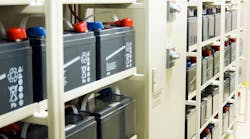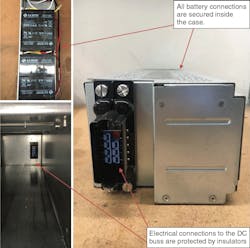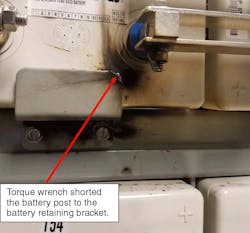Uninterruptible power supply (UPS) systems have come a long way since the original designs of the 20th century. Many of these improvements make systems more reliable, faster to repair, and safer for service personnel. Manufacturers have worked hard to reduce the weight, size, and cost of the systems, giving end-users additional space for IT equipment. One way they have accomplished this is by removing the input and output isolation transformers. The advantages and disadvantages have been discussed in numerous articles and whitepapers. This article specifically examines how removing the input transformer has affected the battery plants and the ability to safely service them.
The ABCs of a UPS
Reviewing the basic building blocks of a UPS system can help us understand how removing the input transformer would affect the operation of UPS system and the battery system.
The original double-conversion type UPS system (Fig. 1) was made up of the following:
• Input transformer
• Rectifier
• Inverter
• Output transformer
• Static switch
• Batteries
The first component is the input transformer, which performs several functions, including isolating the UPS system from the electric utility system, allowing for a 12-pulse rectifier, and reducing input current distortion. Of course, it can also be used to change the input voltage from one level to another. For example, a 480V source could be stepped down to 208V.
The next major component in this type of system is the rectifier. The primary function of the rectifier is to convert incoming AC power to DC power, which can then be used to support the input to the inverter and charge the batteries.
Continuing across Fig. 1 is the inverter, which converts DC voltage to AC voltage and supplies power to the output isolated transformer. The output transformer supplies conditioned power to the critical load.
A static switch, shown above the rectifier and inverter, is used to transfer the critical load from the inverter to the bypass line if there is a failure of the UPS system or if maintenance is required.
The last component in this type of system is the batteries. If input power is lost — typically because of an electric utility outage — then the batteries provide power to the inverter.
Risky removal
One advantage of the input transformer is it isolates the batteries from the ground reference. The input transformer on these systems prevents a voltage potential between the DC bus, including the batteries and ground. If a short were to occur between the two, there would be no return path for current, and it could not flow (Fig. 2). If a battery did short to ground, then most systems have a circuit that would alarm. The system would often continue to operate until it could be shut down and the danger was eliminated.
With removal of the input transformer, the DC bus is no longer isolated from ground. There is both AC and DC potential between the batteries and ground, which includes the racks and cabinets. Because of this potential, if any conductive material (including humans) is connected, then current could flow through the item. This could lead to damaged tools, batteries, racks, or worse — injury or death of personnel (Fig. 3 ).
Maintenance considerations
It’s common practice on the original double-conversion type UPS systems to perform as much battery maintenance as possible while the UPS system is online supporting load. This allows for the critical load to stay protected during battery maintenance.
Vented batteries often have four preventive maintenances (PM) visits completed per year, while the UPS system has two. The two additional battery maintenance visits can be completed with very little risk to the critical load, allowing for the work to be completed during normal working hours.
Valve-regulated lead acid (VRLA) batteries typically have two PM visits per year in conjunction with the UPS system. The battery maintenance is completed while the UPS system is online. Or, if it isn’t a major UPS system inspection requiring a transfer to bypass, the batteries do not have to be taken offline at all.
Over the last 10 years, a few manufacturers have started supplying VRLA batteries inside a container often referred to as a “battery can” or “battery module” (Fig. 4).
Modular battery systems have the same electrical dangers as open racks or battery cabinets. However, because the batteries are enclosed in a sealed box, there is no chance they can come into contact with personnel or ground. This gives a built-in safety feature during maintenance because all the battery connections are enclosed and can’t come into contact with tools or personnel.
Although modular batteries require periodic maintenance, it’s not as invasive as traditional VRLA or vented batteries. Instead of using specialized test equipment to test each jar’s voltage, internal resistance, and specific gravity, if applicable, the UPS system runs a battery test at preprogrammed dates. If a problem is found, an alarm is generated and appropriate personnel notified. This essentially eliminates risk to service personnel because there is no contact with the batteries while the system is online.
Battery most likely to succeed?
Over the last several years and for the foreseeable future, the use of lithium-ion (Li-ion) batteries to support UPS systems continues to increase. Again, the electrical danger of removing the input transformer would be the same as lead-acid batteries. However, much like the modular battery systems, the danger is reduced by the type of installation and the maintenance that is required. Personnel would not be exposed to the DC bus, and this reduces risk.
An example of the dangers involved can be seen in a recent event that occurred when a modern UPS system without an input transformer had an annual PM performed on its batteries. During the PM procedure, bolt re-torque activities were being completed. There was not enough clearance for an insulated torque wrench, so the technician used his uninsulated torque wrench. After completing about half the plant, the technician’s wrench made contact with a battery-retaining bracket while still in contact with the terminal bolt. This caused a bolted fault between the DC bus and ground, resulting in damage to the battery post, the battery rack, and the torque wrench (Fig. 5). Thankfully, the worker suffered no injuries.
Risk reduction
Using Li-ion or modular batteries would have prevented this incident from happening. However, not all installations are Li-ion or modular. What can be done to reduce the risk to personnel on these systems?
First and foremost, educate everyone who will be working with or around UPS systems of the dangers involved. In addition, use insulated tools and provide barriers where possible to prevent anyone from coming into contact with uninsulated battery terminals.
Whenever possible, all maintenance should be completed with the batteries disconnected from the UPS charging circuit. This will prevent a return path for current if contact is made between any battery connection and ground.
As with any service work in the electrical field, it’s important to understand any and all dangers before working on or near equipment. Wherever possible, reduce or remove the danger before work is started. This not only protects the equipment but, more importantly, it also protects you.
DeLauter is the operations manager for Static Power Conversion Services, Inc., in Columbia, Md. He can be reached at [email protected].








